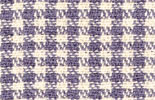|
 A
few years ago, two weavers from the Southern Highland Craft Guild traveled
together to Scotland. While in Kilbarchan, a town near Glasgow, they paid a
visit to the Weaver's Cottage, a small building housing displays of the
region's hand weaving history. Little did these women suspect that inside
they would find the materials and inspiration for a large-scale undertaking
that would involve over 75 weavers, create bonds between weavers in two
countries and eventually lead to an exhibition at the Blue Ridge Parkway's
Folk Art Center. A
few years ago, two weavers from the Southern Highland Craft Guild traveled
together to Scotland. While in Kilbarchan, a town near Glasgow, they paid a
visit to the Weaver's Cottage, a small building housing displays of the
region's hand weaving history. Little did these women suspect that inside
they would find the materials and inspiration for a large-scale undertaking
that would involve over 75 weavers, create bonds between weavers in two
countries and eventually lead to an exhibition at the Blue Ridge Parkway's
Folk Art Center.
 Marjorie
Warren, of Lake Junaluska, NC, and Barbara Miller, of Pisgah Forest, NC,
discovered old books containing weaving patterns (drafts), from the 19th
century. They learned these hundred-plus year-old penciled notations hadn't
seen a loom since the craft was replaced by machines of the Industrial
Revolution. Finding no samples of the fabrics, Warren and Miller inquired if
they could interpret the information themselves. Marjorie
Warren, of Lake Junaluska, NC, and Barbara Miller, of Pisgah Forest, NC,
discovered old books containing weaving patterns (drafts), from the 19th
century. They learned these hundred-plus year-old penciled notations hadn't
seen a loom since the craft was replaced by machines of the Industrial
Revolution. Finding no samples of the fabrics, Warren and Miller inquired if
they could interpret the information themselves.
In an exhibition entitled "Tracing Our Threads: The Kilbarchan Weaving
Project," 80 weaving drafts have been copied from these historic tomes and
woven into fabric by American hand-weavers. In the Folk Art Center's
Interpretive Gallery from April 13-October 6, 2002, the work of over 75
weavers bring history out of the books and into the public eye.
 These
Kilbarchan textiles are not the fabrics of ceremony or ornament, but rather
the sturdy weaves of everyday life. The over 400 weavers in 19th-century
Kilbarchan once made their livings weaving useful items like towels,
napkins, bedding and everyday clothing. Necessary and common, these simple
weaves were the first to be mechanically replaced by "cloth-making
machines," and by 1815 the textile industry was catapulted into a new level
of production. The shuttles of Kilbarchan were slowly silenced. Notations
casually scrawled by weavers for themselves and each other relating fibers
used, cloth structure, and costs, were lucky to have been saved at all.
Often such records disappeared along with the weavers who created them. These
Kilbarchan textiles are not the fabrics of ceremony or ornament, but rather
the sturdy weaves of everyday life. The over 400 weavers in 19th-century
Kilbarchan once made their livings weaving useful items like towels,
napkins, bedding and everyday clothing. Necessary and common, these simple
weaves were the first to be mechanically replaced by "cloth-making
machines," and by 1815 the textile industry was catapulted into a new level
of production. The shuttles of Kilbarchan were slowly silenced. Notations
casually scrawled by weavers for themselves and each other relating fibers
used, cloth structure, and costs, were lucky to have been saved at all.
Often such records disappeared along with the weavers who created them.
It was sheer fortune that the Kilbarchan Weaving Cottage had preserved the
written history. And fortune, also, that Barbara Miller and Marjorie Warren
had the means to interpret them. Through the fall of 2000, the two weavers
paged through these fragile journals, too delicate to photocopy, and
transcribed each draft into a computer database. The Kilbarchan Project, as
it came to be known, was supported by the Southern Highland Craft Guild and
Scottish Heritage USA, and grew with the help of the Western North Carolina
Fiber Guild. The 77 weavers from several states who took up the challenge
were issued Scottish yarns with which to weave each sample. The labor has
been long and taxing, working with extremely fine yarns in often monotonous
patterns. One foot of fabric averages 2-1/2 hours to make. Whenever weavers
complained about the difficulty, Marge Warren reminded them of the added
difficulty the weavers of the 1800s had, "At least you have electricity."
"Tracing Our Threads" is displayed in conjunction with the major exhibition
"Celebrating Scotland's Crafts," organized by the National Museums of
Scotland, appearing in the Folk Art Center's Main Gallery from May
4-September 29, 2002.
The Folk Art Center is located on the Blue Ridge Parkway at Milepost 382.
For exact driving directions from any starting point or further information
on the exhibitions, please call the Folk Art Center at 828-298-7928 or visit
the Southern Highland Craft Guild's web site,
www.southernhighlandguild.org.
Thanks to Tom Leslie,
www.asheville.com for giving us
permission to use this article and he mentioned in his reply "Yes, that is
fine, and with being a "Leslie" with deep Scottish roots, I think it is
actually a swell idea." |

